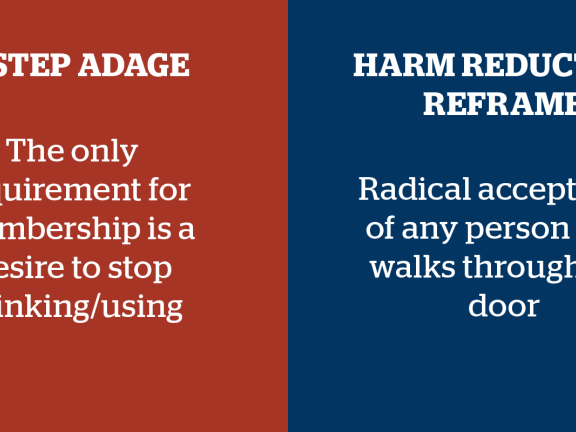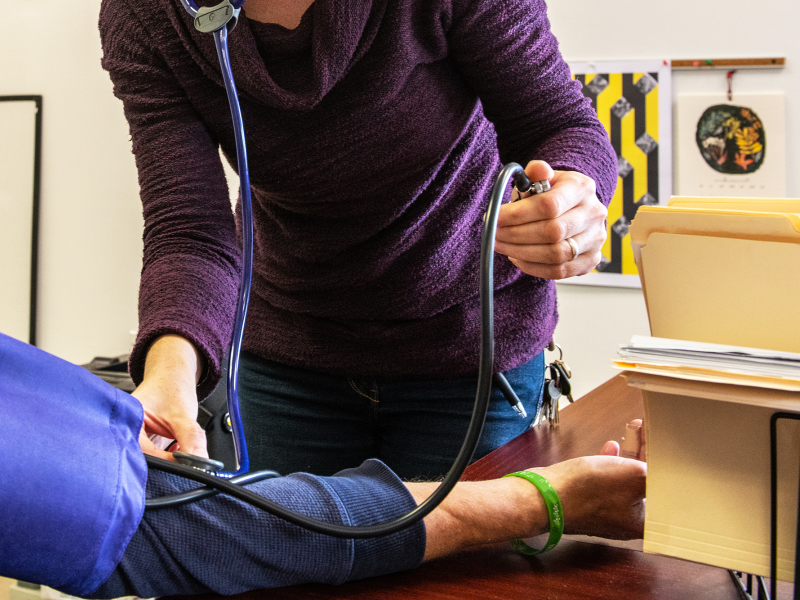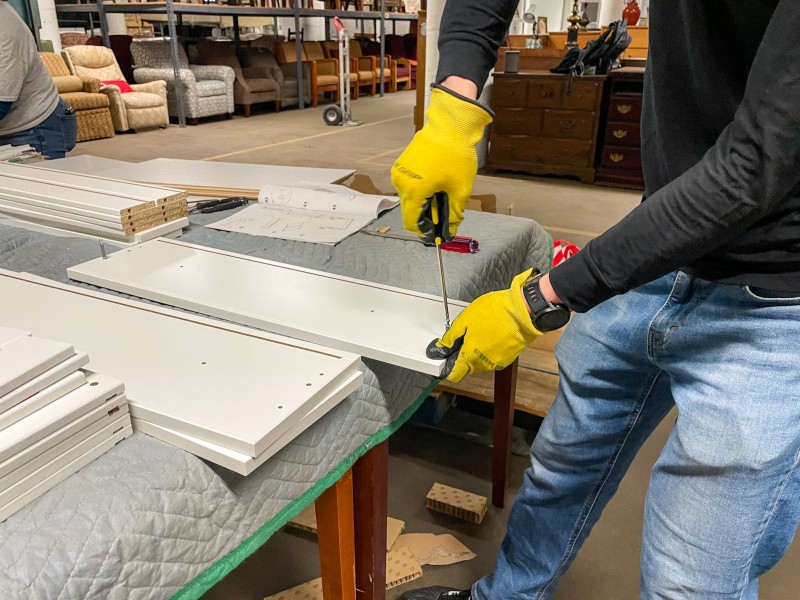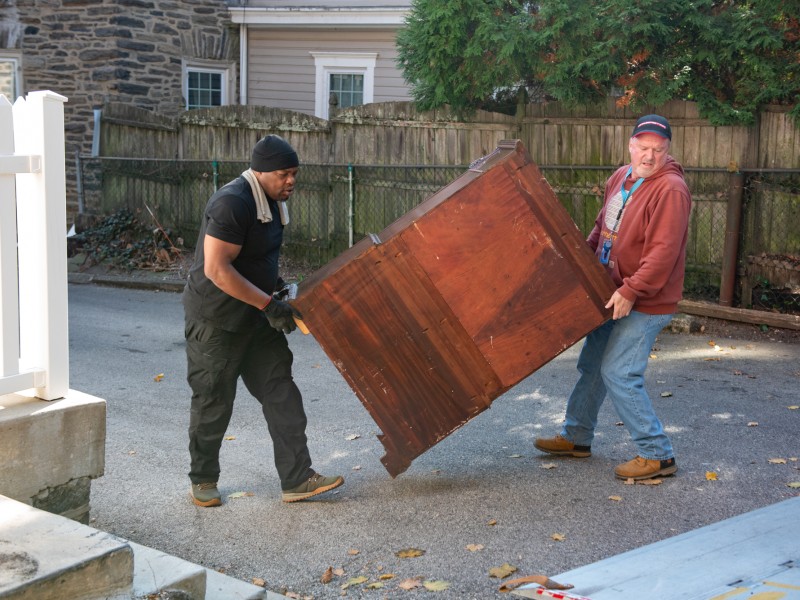Are Harm Reduction and 12 Step Recovery Really That Different?

I don’t believe that harm reduction and 12-step recovery are the polar opposites they’ve been made out to be. But like many others, my introduction to harm reduction work was not without its awkward moments. As a first-year graduate social work student, I learned about all of the harm reduction tools provided to program participants on the first day of my field placement. I knew the agency offered clean syringes to folks using intravenous drugs in order to help prevent the spread of blood-borne diseases such as HIV and Hepatitis C. It was a shock to me, however, to learn that we also provided cookers, cotton, saline, tourniquets, safe smoking kits, and more. The staff member giving me a tour of the office on my first day noticed the look of consternation on my face and graciously addressed the question he’d assuredly answered hundreds of times before from novices like myself— “isn’t this enabling?”
As someone with both a professional and personal background in the 12-steps and abstinence-based recovery, my lens for working with individuals using substances focused on the cessation of all drug use— not because I didn’t believe in person-centered services or the autonomy of those with whom I was working, but because it was all I had been taught. Information about abstinence-based recovery was the only kind of recovery orientation I had access to until that moment.
The staff member kindly explained how all of the safer injection supplies distributed were actually quite necessary to keep people safe—and effective, as well. In fact, the Philadelphia Department of Public Health recorded a 34% decrease in new HIV infections among intravenous substance users following the introduction of harm reduction programs in the city. Knowing and loving countless friends managing Hepatitis C acquired through substance use, and as a person of queer and trans experience witnessing the impact of the HIV/AIDS epidemic on LGBTQ+ communities, understanding safety as the ultimate goal of harm reduction was all it really took for me to get it.
Outside of my field placement hours—whether back in class or conversing with friends from my chosen 12-step fellowship— I was met with both shock and concern whenever I relayed information about the harm reduction work I was doing. On the flip side, whenever my personal and professional familiarity with abstinence-based recovery was mentioned among harm reduction activists and advocates, people seemed somewhat wary and questioned my intentions within that environment. I felt myself code-switching throughout the day: harm reductionist for 9:00 am morning meetings, 12-stepper for a lunch break phone call, harm reductionist for afternoon syringe exchange hours, 12-stepper for evening meeting and fellowshipping. My vocabulary shifted back and forth between 12-step sanctioned words like addict, clean, and relapse, to person-first language, such as, drug misuse, active use, person with a substance use disorder, and person in long-term recovery. For a while, it was frustrating and challenging, but eventually it became second nature.
As I shared with others about my experiences navigating these two distinct spaces, the more it became clear that there were folks on both sides of the fence who were not fully comfortable with my ability to reconcile, what they viewed as, conflicting philosophies. Yet, there are countless 12-step adages that mirror harm reduction ideology. The more time I’ve spent training others on harm reduction, and the more time I’ve accumulated on my personal recovery journey, the more apparent the overlap between these two approaches has become.
| 12 Step Adage | Harm Reduction Reframe |
| The only requirement for membership is a desire to stop drinking/using. | Radical acceptance of any person who walks through the door. |
In the first few minutes of any Narcotics Anonymous meeting you’ll hear the statement, “we are not interested in what or how much you used or who your connections were, what you have done in the past, how much or how little you have, but only in what you want to do about your problem and how we can help.” Similarly, the Third Tradition of both the Alcoholics Anonymous and Narcotics Anonymous fellowship asserts “the only requirement for membership is a desire to stop drinking/using.” Both are reminiscent of the harm reduction principle of practicing radical acceptance of any person who walks through the door. In the rooms of a 12-step fellowship, individuals are welcomed with open arms. If they show up intoxicated, they’re not asked to leave, and they’re encouraged to keep coming back. In a harm reduction program, staff meet the client where they are and seek to address their needs in a way that encourages the individual to return and access care or support services on an ongoing basis. Both utilize non-judgmental support of individuals without precondition, and promote regular engagement and relationship-building as the primary tool of help.
| 12 Step Adage | Harm Reduction Reframe |
| The therapeutic value of one addict/alcoholic helping another. | Peer support is a key component of effective treatment or support. |
We’ve all heard the phrase “you don’t get fed with a closed mouth.” Both 12-step recovery and harm reduction seek to break the cycle of shame and stigma around addiction by encouraging open, honest communication, and both utilize the power of peer support to do so. Sponsorship and the therapeutic value of one addict/alcoholic helping another, mentioned so often in 12-step rooms, are not dissimilar concepts to the use of peer specialists in harm reduction programs. Harnessing the lived experience of individuals who have faced and overcome challenges with substance use, or those who have found ways to successfully manage their use, is a keystone of harm reduction work. Additionally, the most successful harm reduction programs are informed in their development by those directly impacted by the problem, while 12-step fellowships are fully self-supporting groups, employing a for members/by members structure.
Both approaches make suggestions for the individual seeking help and refrain from placing demands or expectations on behavior. 12-step members base any advice or suggestions shared on their experience, strength, and hope, but individuals are rarely given overt direction. While a sponsor may certainly have feedback on a newcomer’s decision-making process, the onus is on the individual to take responsibility for their path forward, similar to the way that harm reductionists promote self-determination.
We know that everyone has different needs. As such, not every sponsor, meeting, or fellowship has the right personality or style for every recovering person. Similarly, not every harm reduction program or provider has a palatable approach for all individuals seeking services. Some want a tell it like it is helper, while others prefer a gentler touch. Either way, harm reductionists and 12-step fellowships each want to provide individualized help in a way that increases the odds that someone will return. Both harm reductionists and 12-step members care deeply about the well-being of others and share a sincere investment in the helping process.
| 12 Step Adage | Harm Reduction Reframe |
| 1. We admitted that we were powerless over alcohol/our addiction—that our lives had become unmanageable 2. We came to believe that a Power greater than ourselves could restore us to sanity 3. We made a decision to turn our will and lives over to the care of God as we understood Him | 1. Contemplation 2. Preparation 3. Action |
Many abstinence-only recovery purists believe that harm reduction enables individuals to continue down a path of self-destruction without consequences or self-reflection. But 12-step members and harm reductionists alike aim to help individuals navigating substance use issues to acknowledge the disconnection between their actions and their stated goals. In 12-step fellowships, this often happens through sponsorship and step work. We hear it echoed in phrases like “you can’t spot self-deception,” and “an addict/alcoholic alone is in bad company.” In harm reduction, we can see this in treatment plans, personal goal plans, or more informal conversations about the change process, which are often informed by the Transtheoretical Model, or The Stages of Change. In a way, accessing treatment through a harm reduction program mirrors the first three steps of AA/NA—
1. Becoming aware of a problem or need,
2. Acknowledging that help is required,
3. Asking for that help.
Both harm reduction and 12-step approaches acknowledge that relapse or recurrence of use is a reality for many people on a path of recovery. In the rooms, you’ll hear phrases like “progress not perfection,” or “a relapse may be the jarring experience that brings about a more rigorous application of the program.” Harm reductionists accept that recovery is not always a straight line and recurrence of use is normalized as common, or even expected, but never a necessity.
| 12 Step Adage | Harm Reduction Reframe |
| Take the steps | Any positive change |
We know that, in a 12-step fellowship, the end goal is abstinence. With harm reduction, the end goals are safety and bodily autonomy. These things are not mutually exclusive. Both harm reduction and abstinence-based recovery approaches aim to keep the person alive, and hope that, in time, the individual can improve their overall well-being. Both seek to assist the individual in becoming happier and healthier through a process of incremental change (one day at a time; first things first). Harm reductionists and 12-step members acknowledge that miracles don’t happen overnight, advocating for short term goals (just for today; change is a process, not an event) and long-term goals (including, but not limited to, safety, stable housing, reengaging with family/friends/community, self-support, freedom from trauma/the carceral state, and/or abstinence). In both settings, the individual builds confidence through small wins, achievement, and mastery. As this process continues, the larger goals begin to feel more realistic and possible (lost dreams awaken). Both acknowledge that recovery is a journey, not a destination.
There are a lot of nuances to this conversation, and I have not addressed the many misalignments between abstinence-based recovery and harm reduction here. While I could argue with myself about it all day, 12-step recovery has taught me to look for similarities, not differences, when I’m in need of help. There are plenty of folks out there who won’t agree with my personal interpretation of how harm reduction and 12-step/abstinence-based recovery mirror and complement each other. That’s okay. Like many have said before me—just take what you need and leave the rest.


